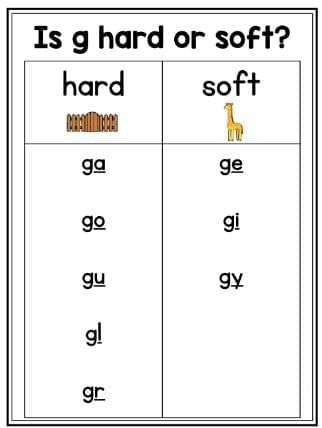Soft G and C Chapter Notes | Language Arts for Grade 2 PDF Download
| Table of contents |

|
| Introduction |

|
| What Are the Hard and Soft Sounds of G and C? |

|
| When Do You Teach Hard and Soft G and C Sounds? |

|
| How Do You Teach Hard and Soft G and C Sounds? |

|
Introduction
The letters G and C can be confusing! When students mix up their hard and soft sounds, a phrase like “Let’s race!” might accidentally turn into “Let’s rake!”
In this post, I’ll clarify the distinction between hard and soft sounds for G and C. I’ll also describe my approach to teaching these sounds and explain the timing of when I introduce them.
What Are the Hard and Soft Sounds of G and C?
- The letter G produces two distinct sounds: /g/ or /j/.
- The hard G sound is more frequent than the soft G sound: The hard G is pronounced as /g/, like in "gum." The soft G is pronounced as /j/, like in "giant."
- The letter C also has two sounds: /k/ or /s/.
- The hard C sound is more common than the soft C sound: The hard C is pronounced as /k/, as in "cat." The soft C is pronounced as /s/, as in "city."
Here’s a list of words demonstrating hard and soft G and C sounds:
- Hard G: goal, goat, gas, gutter, go, game
- Soft G: gem, giraffe, gist, gym, germ
- Hard C: cup, coat, carrot, cow, can, curly
- Soft C: cent, circus, cereal, circle, center, cyclone
These sounds can appear at the end of words (e.g., rug, picnic) or in the middle of words (e.g., rigid, bicycle).
As with most phonics rules, there are exceptions. For the hard and soft G, several words don’t follow the typical patterns, such as give, begin, get, girl, and gift (I’ll discuss the rules later in this post).
Some words are particularly interesting because they contain both hard and soft sounds, like "recycle" and "reconcile."
When Do You Teach Hard and Soft G and C Sounds?
In my phonics program, From Sounds to Spelling, I introduce the hard sounds of C and G during the Kindergarten curriculum.
If you use the term “hard” when teaching these sounds, it can lay a foundation for when students later learn the soft G and C sounds.
I introduce the soft C sound toward the end of 1st grade, followed by the soft G sound at the start of 2nd grade.
An important note: While I introduce these sounds to support reading, I don’t expect students to master spelling words with these sounds until after 2nd grade.
How Do You Teach Hard and Soft G and C Sounds?
The key to distinguishing these sounds is to ask, “What letter follows the G or C?” This helps identify whether the sound is hard or soft.
When introducing the hard and soft G, I use an interactive activity to encourage students to notice the difference. You can distribute word cards (possibly with images for support) and have students sort themselves into two groups: one with words starting with a soft G and the other with words starting with a hard G.
- Example: “Some words have a hard G sound, like /g/, while others have a soft G sound, like /j/.”
You can extend the activity by prompting students to identify patterns about when G produces the /g/ sound versus the /j/ sound. - Example: “The letter G’s sound depends on the letter that comes after it.” Go over the letters that cause G to make the hard sound, as in “gate” (o, a, u, r, l), and those that cause it to make the soft sound, as in “giraffe” (e, i, y).
Finally, I display the “Is G Hard or Soft?” poster as a written reference for students to use when applying this rule.
The hard and soft C can be taught in a similar way. The sound of the letter C varies based on the letter that follows it. Go over the letters that trigger the hard C sound, as in “cap” (o, a, u, r, l), and those that trigger the soft C sound, as in “face” (e, i, y).
Sorting words or pictures is another effective activity for practicing hard and soft G and C sounds.
Conclusion
I hope this explanation of hard and soft G and C sounds proves useful! If you’re looking for additional resources to teach this or other phonics skills, explore my phonics program, From Sounds to Spelling.
|
138 videos|157 docs|51 tests
|
FAQs on Soft G and C Chapter Notes - Language Arts for Grade 2
| 1. What is the difference between hard and soft sounds of G and C? |  |
| 2. When should teachers introduce hard and soft sounds of G and C to students? |  |
| 3. What activities can be used to teach hard and soft G and C sounds effectively? |  |
| 4. How can parents support their children in learning hard and soft sounds at home? |  |
| 5. Why is it important for students to learn the hard and soft sounds of G and C? |  |














